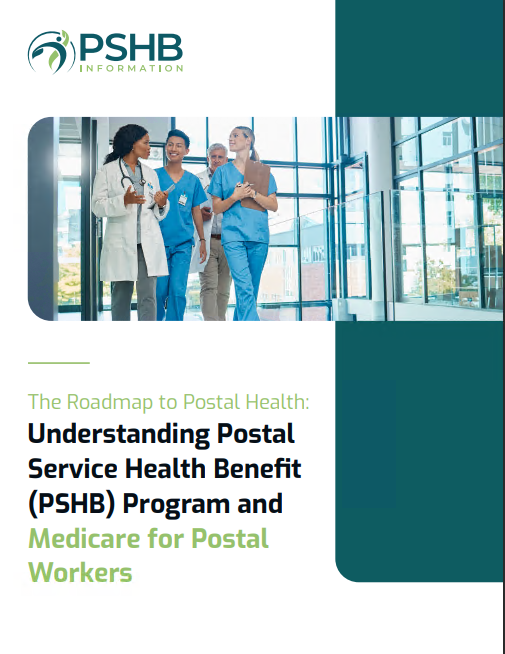Key Takeaways
-
The Postal Service Health Benefits (PSHB) Program launching in 2025 brings significant changes that USPS employees need to understand and prepare for.
-
Open Season is your chance to evaluate your options and secure the right health coverage for you and your family.
A Major Update to Your Healthcare Options
If you work for USPS, you’re about to experience one of the biggest updates to your health benefits in decades. Starting January 1, 2025, the Postal Service Health Benefits (PSHB) Program will replace the Federal Employees Health Benefits (FEHB) Program for postal workers and retirees. These changes aim to create plans better tailored to your needs while integrating more effectively with Medicare for retirees.
There’s a lot to consider, but don’t worry—we’ll help you navigate these updates so you can make confident, informed decisions.
Why Is PSHB Being Introduced?
This transition is about creating a more sustainable and relevant health benefits program for USPS workers. Here’s what’s driving the change:
-
Focused Coverage: Unlike FEHB, PSHB plans are specifically designed for USPS employees, retirees, and their families, offering targeted benefits tailored to your needs.
-
Cost Efficiency: Rising healthcare costs and USPS’s financial challenges mean a shift toward more cost-effective and sustainable options.
-
Medicare Integration: For retirees, better alignment with Medicare ensures comprehensive coverage and helps minimize out-of-pocket costs.
Key Dates You Should Know
Staying on top of important deadlines is critical during this transition:
-
Open Season: November 11 to December 9, 2024. This is when you can compare plans and choose the one that fits your needs.
-
Effective Date: January 1, 2025. Your new PSHB plan will officially take over.
These dates are non-negotiable, so mark your calendar and plan ahead.
How Does PSHB Compare to FEHB?
Tailored Plan Options
PSHB plans are crafted with USPS employees in mind, which means:
-
Relevant Benefits: Coverage that aligns with the unique needs of postal workers, addressing occupational health risks and challenges.
-
Improved Access: Enhanced focus on providing coverage for workers in underserved or remote areas.
Medicare Coordination for Retirees
For retirees, the integration with Medicare is a game-changer:
-
Comprehensive Coverage: Medicare serves as your primary coverage, while PSHB fills in the gaps for services not fully covered.
-
Cost Savings: Coordinated plans reduce redundancies and help lower overall expenses.
What Action Steps Should You Take?
Current Employees
Even if you’re not retiring anytime soon, understanding these changes now will help you prepare for the future. Key considerations include:
-
Stay Informed: Keep up with USPS updates and announcements about the PSHB transition.
-
Plan for Retirement: Learn about Medicare Part B requirements and costs to avoid surprises later.
Retirees
For those already retired, your coverage will transition automatically, but there are some essential steps to take:
-
Enroll in Medicare Part B: If you’re eligible for Medicare, enrolling in Part B is critical for maintaining PSHB coverage. The standard premium for 2025 is $185 per month, with a $257 annual deductible.
-
Check Exemptions: Retirees who left USPS on or before January 1, 2025, and are not enrolled in Part B are exempt from this requirement.
Understanding Medicare Part B’s Role
Medicare Part B works hand-in-hand with PSHB to offer comprehensive healthcare coverage. Here’s how it breaks down:
-
Primary Coverage: Medicare covers outpatient services, preventive care, and doctor visits, while PSHB supplements those benefits.
-
Predictable Costs: Though there’s an added cost for Medicare Part B premiums and deductibles, the combined coverage minimizes large out-of-pocket expenses.
What Are the Benefits of PSHB?
Preventive Care
PSHB plans emphasize keeping you healthy with full coverage for preventive services, including routine check-ups, screenings, and vaccinations. Catching health issues early saves money and ensures better long-term outcomes.
Mental Health Support
Recognizing the growing need for mental health care, PSHB includes expanded access to counseling and therapy services. These benefits prioritize your mental well-being as part of comprehensive healthcare.
Prescription Drug Coverage
PSHB integrates with Medicare Part D, capping annual out-of-pocket costs for prescription medications at $2,000. This change brings financial relief to those managing chronic conditions or expensive treatments.
How to Navigate Open Season
Open Season is your chance to take control of your healthcare. Here’s a step-by-step guide to ensure you make the best choices:
-
Review Your Current Plan: Assess whether your current FEHB plan meets your needs or leaves gaps.
-
Compare PSHB Plans: Look at premiums, deductibles, and benefits to find the best match for you and your family.
-
Plan for Medicare Enrollment: If you’re approaching age 65, learn about Medicare enrollment timelines and associated costs.
-
Ask Questions: Reach out to USPS HR or the Office of Personnel Management (OPM) for any clarification you need.
Common Questions About the Transition
Will My Coverage Be Interrupted?
No. If you’re currently enrolled in FEHB, your coverage will transition seamlessly to PSHB. Automatic enrollment ensures no gaps in coverage.
Can I Keep My Current Doctors?
Most PSHB plans have extensive provider networks, but it’s always wise to confirm that your preferred healthcare providers are included.
What Happens If I Don’t Enroll in Medicare Part B?
Failing to enroll in Medicare Part B, if required, could result in losing your PSHB coverage. Understanding these requirements is crucial.
Preparing for a Smooth Transition
Here are some tips to make the PSHB transition as seamless as possible:
-
Set Reminders: Don’t miss key deadlines for Open Season or Medicare enrollment. Use alerts or mark your calendar.
-
Stay Organized: Keep all healthcare-related documents, such as Medicare enrollment confirmations and plan details, in one place.
-
Communicate With Dependents: Make sure family members covered under your plan understand the changes and what actions they might need to take.
Why This Change Is a Positive Step
Though the transition may feel overwhelming, the PSHB Program brings real advantages:
-
More Tailored Plans: Coverage specifically designed for USPS employees and retirees ensures benefits that align with your needs.
-
Cost Management: Out-of-pocket cost caps and Medicare integration offer financial predictability.
-
Expanded Benefits: PSHB plans reflect modern healthcare priorities, such as mental health and preventive care.
Getting Ready for a New Healthcare Chapter
The 2025 launch of the Postal Service Health Benefits Program is a pivotal moment for USPS employees and retirees. By understanding the changes, preparing during Open Season, and addressing Medicare requirements, you can secure a health plan that works for you. These updates offer an opportunity to align your healthcare with your needs, ensuring better care and cost management for years to come.







